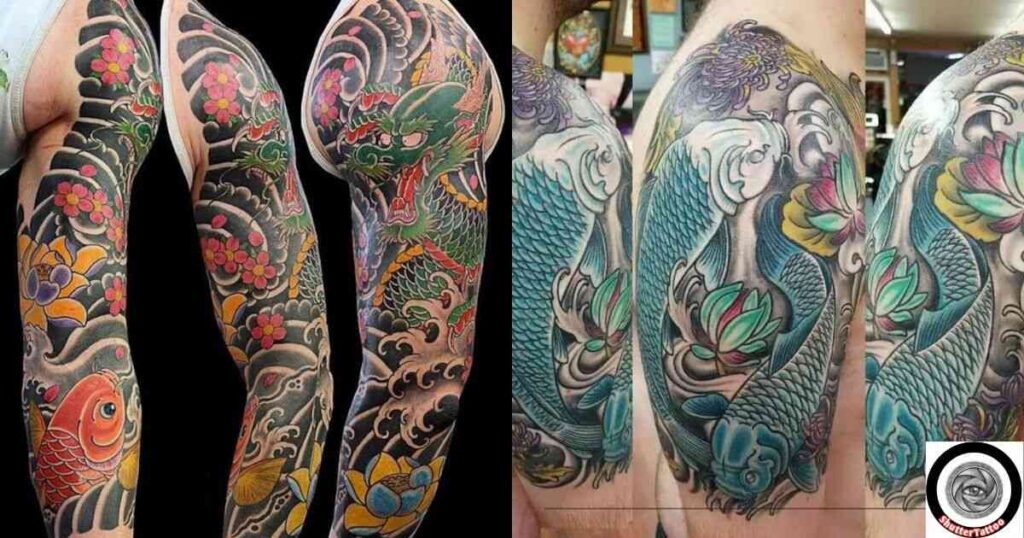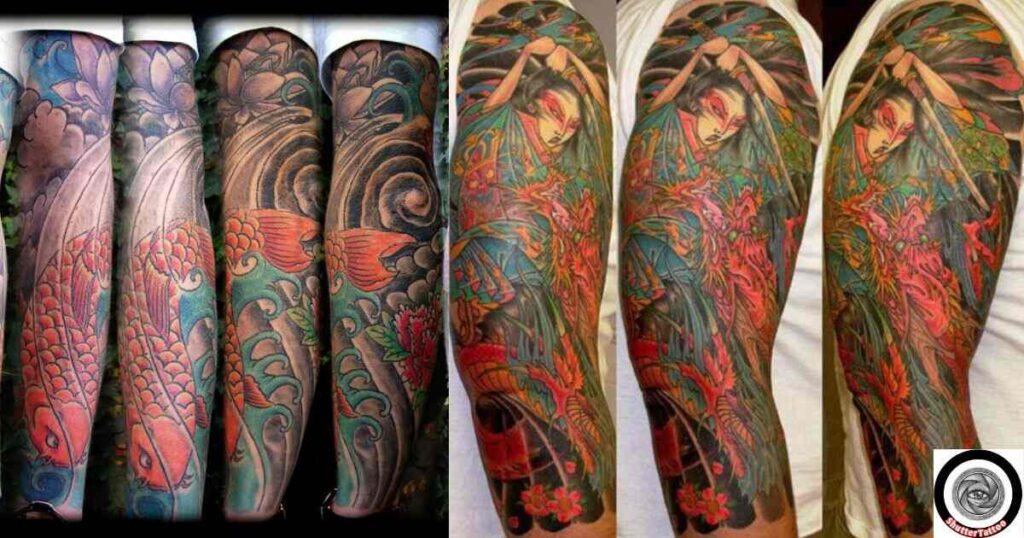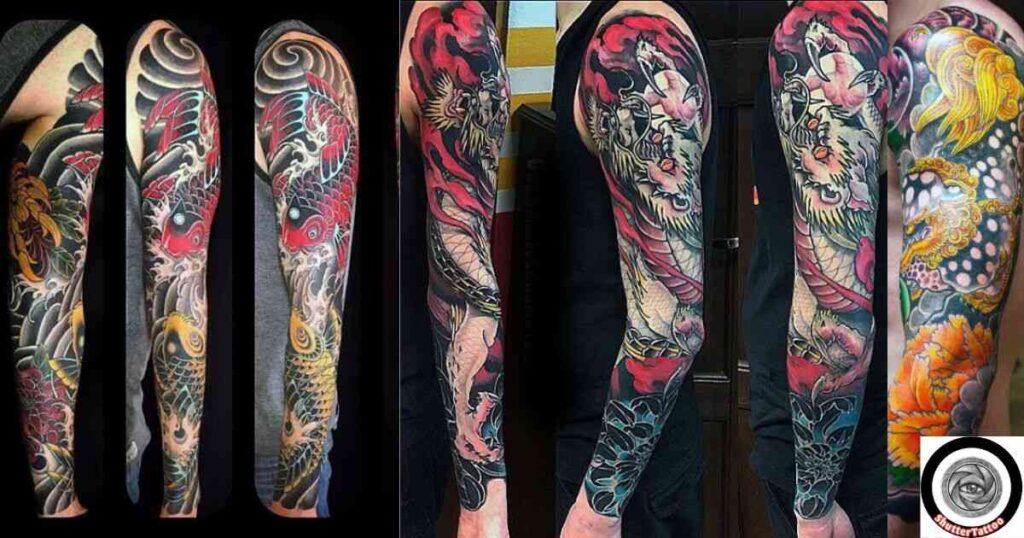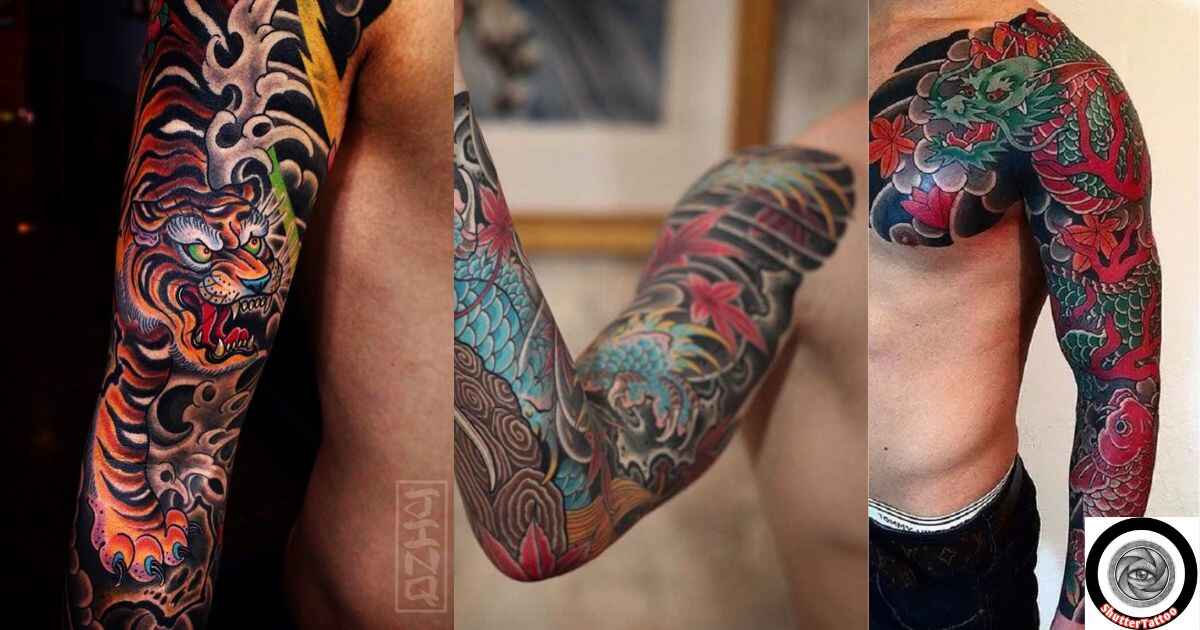Japanese sleeve tattoos, know as Irezumi, are more than just intricate designs. They are profound narratives etched onto the skin. Each motif, from the majestic dragon symbolizing strength and wisdom to the resilient koi fish representing perseverance, tells a unique story deeply rooted in Japanese culture.
These tattoos blend art and symbolism, offering a canvas that reflects personal journeys and cultural appreciation. As we delve into the world of Japanese sleeve tattoos, we’ll uncover the rich history, meanings, and artistry that make them a timeless form of self-expression.
Historical Background of Japanese Tattoos

The art of tattooing in Japan dates back to the Jōmon period (circa 10,000 BC), where clay figurines, known as dogū, display facial and body markings that suggest early tattoo practices. The markings are believe to have held spiritual or decorative significance.
During the Yayoi period (300 BC – 300 AD), Chinese historical texts note that Japanese individuals adorn their bodies with tattoos, which was thought to possess spiritual meanings and denote social status.
However, in the Kofun period (300 – 600 AD), tattoos begin to use as a form of punishment for criminals, marking a shift in their societal perception. This association with criminality persisted, especially during the Edo period (1603 – 1868), where tattoos was employe to brand offenders.
Despite these negative connotations, the Edo period also witnessed the rise of decorative tattooing as an art form. Inspired by ukiyo-e (floating world) woodblock prints and popular literature, intricate designs featuring mythical creatures, deities, and natural elements became prevalent. Artisans, originally trained in woodblock printing, adapted their skills to tattooing, leading to the development of the traditional Japanese tattooing style known today.
Understanding Sleeve Tattoos
In Japanese tattooing, sleeve tattoos are category base on the coverage of the arm:
- Full Sleeve (Nagasode): Extends from the shoulder to the wrist, covering the entire arm.
- Half Sleeve: Covers the upper arm from the shoulder to the elbow or the forearm from the elbow to the wrist.
- Quarter Sleeve: Typically spans from the shoulder midway down the upper arm or from the wrist midway up the forearm.
Traditional Japanese sleeve tattoos are meticulously plan to ensure harmony and flow with the body’s natural contours. A central motif, such as a dragon or koi fish, is often surround by complementary elements like waves, clouds, or floral patterns. This composition not only enhances the visual appeal but also imbues the tattoo with layered meanings, reflecting themes like strength, perseverance, or the transient nature of life.
Common Motifs in Japanese Sleeve Tattoos

Japanese sleeve tattoos are renown for their rich symbolism and intricate designs. Common motifs include mythical creatures, animals, floral elements, and cultural icons, each carrying profound meanings.
Mythical Creatures
- Dragons: In Japanese culture, dragons are revered as benevolent beings symbolizing strength, wisdom, and protection. Unlike their Western counterparts, Japanese dragons are often associated with water and are believed to control rainfall and rivers. In tattoos, they represent power and are thought to bring good fortune.
- Phoenix: Known as “Hou-ou” in Japan, the phoenix symbolizes rebirth, immortality, and renewal. Often depicted rising from flames, it embodies the idea of overcoming adversity and emerging stronger. Incorporating a phoenix into a sleeve tattoo can signify resilience and transformation.
Animals
- Koi Fish: Koi is admire for his perseverance and determination. According to legend, a koi swam upstream and transformed into a dragon upon reaching the top of a waterfall, symbolizing ambition and success against all odds. In tattoos, koi fish represent courage and the drive to achieve one’s goals.
- Tigers: Tigers are powerful symbols of courage and protection in Japanese culture. They are believe to ward off evil spirits, disease, and bad luck. A tiger tattoo can convey strength, bravery, and a fierce demeanor.
Floral Elements
- Cherry Blossoms: Known as “sakura,” cherry blossoms are cherished in Japan for their fleeting beauty. They bloom briefly before falling, symbolizing the transient nature of life and the acceptance of mortality. In tattoos, they serve as a reminder to appreciate the present moment.
- Peonies: Referred to as the “king of flowers,” peonies represent wealth, honor, and prosperity. Their lush, full blooms are often used in tattoos to signify elegance and affluence.
Cultural Icons
- Samurai: Samurai warriors epitomize honor, discipline, and loyalty. Tattoos featuring samurai imagery pay homage to these virtues and the Bushido code they followed. Such designs can reflect a commitment to personal principles and a warrior spirit.
- Geisha: Geisha are emblematic of beauty, grace, and artistry. In tattoos, they represent the appreciation of traditional arts and the pursuit of perfection in one’s craft. A geisha motif can denote elegance and a deep respect for cultural heritage.
Design and Placement Considerations

The design and placement of a Japanese tattoo are crucial for aesthetic harmony and symbolic significance. Traditional designs often follow the body’s natural lines, creating a cohesive flow. For example, a dragon might be depicted winding around the arm, emphasizing movement and power. Choosing the right placement enhances the tattoo’s meaning and visual impact.
The Tattooing Process
The traditional Japanese tattooing method, known as Tebori, involves hand-poking ink into the skin using a tool with needles attached to a wooden handle. This technique allows for precise and detailed lines, creating intricate designs. The process is meticulous and can be time-consuming, often requiring multiple sessions to complete a full piece. Each session involves outlining, shading, and coloring, with healing periods in between.
Read This Blog: Atlanta Tattoo Festival: A Comprehensive Guide to the Premier Tattoo Event in Atlanta
Selecting a Tattoo Artist
Choosing the right tattoo artist is essential for achieving a high-quality Japanese tattoo. Look for artists who specialize in Japanese styles and have a comprehensive portfolio showcasing their work. Consultations are vital to discuss design ideas, placement, and to ensure clear communication. A skilled artist will guide you through the process, offering insights into traditional symbolism and design elements.
Aftercare and Maintenance
Proper aftercare is crucial for the longevity and vibrancy of your tattoo. After each session, follow your artist’s instructions, which typically include keeping the tattoo clean, applying recommended ointments, and avoiding direct sunlight and submersion in water during the healing process. Long-term maintenance involves protecting the tattoo from excessive sun exposure and keeping the skin moisturized to prevent fading.
Also Read This Blog: The Ultimate Guide to Chest Quote Tattoos: Meanings, Designs, and Aftercare (2025)
Cultural Sensitivity and Appropriation
When considering a Japanese tattoo, it’s important to approach the art form with respect and understanding. Familiarize yourself with the cultural significance of the motifs you choose and ensure that your design honors the traditions and meanings inherent in Japanese tattooing. This mindful approach helps avoid cultural appropriation and shows respect for the rich history behind the art.
By understanding the symbolism, carefully considering design and placement, selecting a skilled artist, adhering to proper aftercare, and approaching the process with cultural sensitivity, you can obtain a meaningful and respectful Japanese tattoo that honors this ancient art form.
Celebrity Japanese Sleeve Tattoo Designs
Several celebrities have embraced Japanese-style tattoos, incorporating traditional motifs and designs into their body art.
John Mayer: The acclaimed musician sports a full sleeve tattoo on his left arm, crafted by renowned Japanese tattoo artist Horimitsu. This intricate piece showcases traditional Japanese elements, reflecting Mayer’s appreciation for the art form.
Justin Bieber: The pop star completed a sleeve tattoo in 2014, which includes various designs, some influenced by Japanese art. His collection features intricate patterns and symbols that align with traditional Japanese aesthetics.
Ariana Grande: The singer has a tattoo intended to represent her song “7 Rings” in Japanese kanji characters. However, due to a mistranslation, it initially read as “small barbecue grill.” Grande later adjusted the design to correct the error, demonstrating the importance of accuracy when incorporating foreign languages into tattoos.
FAQ
What are Japanese sleeve tattoos?
Japanese sleeve tattoos are intricate designs that cover the arm, often featuring traditional motifs like dragons, koi fish, and cherry blossoms.
How long does it take to complete a Japanese sleeve tattoo?
The duration varies based on design complexity and size, typically requiring multiple sessions over several months.
What do common motifs in Japanese sleeve tattoos symbolize?
Motifs like dragons represent strength, koi fish symbolize perseverance, and cherry blossoms reflect the fleeting nature of life.
Are Japanese sleeve tattoos painful?
Pain levels differ among individuals, but sleeve tattoos can be more painful due to the extensive coverage and detail.
How should I care for my Japanese sleeve tattoo?
Follow your tattoo artist’s aftercare instructions, which usually include keeping the area clean, moisturized, and protected from the sun.
Conclusion
Japanese sleeve tattoos are more than just body art; they are rich in symbolism and cultural significance. Each design element tells a story, reflecting values like strength, perseverance, and the transient beauty of life.
When considering such a tattoo, it’s essential to understand the meanings behind the motifs and to choose a skilled artist who respects the traditional techniques. Proper aftercare ensures the longevity and vibrancy of your tattoo, allowing you to carry a piece of Japanese heritage with you.

